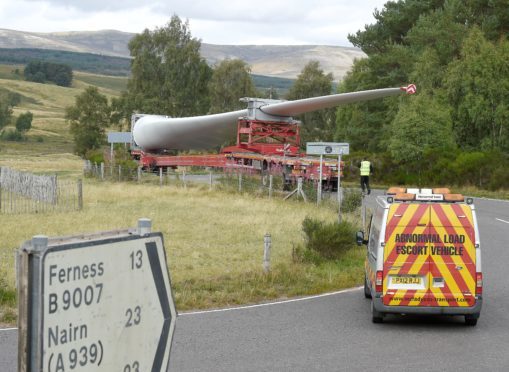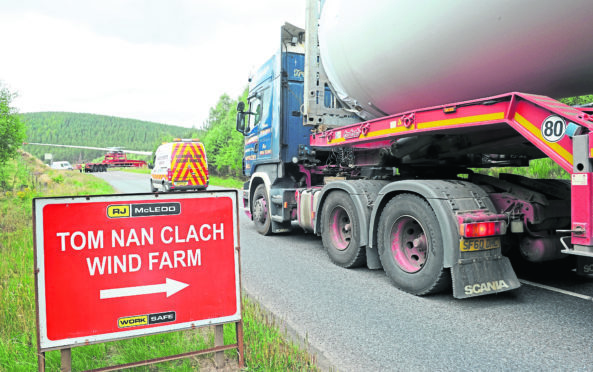Lorries transporting parts that will be assembled to form a controversial new 13-turbine wind farm development at Tom nan Clach were on the move for the first time yesterday, with local motorists facing some delays along the A9.
Three lorries carrying blades that will be placed on the 410ft high towers set off from Inverness Port under police escort shortly after 10.30am, on the 35-mile journey down the A9 Inverness to Perth road before turning onto the A95 at the Granish junction.
The convoy went north through the villages of Dulnain Bridge and Duthil, with motorists facing delays of up to 15 minutes as the long loads navigated their way through tight bends at Duthil to the site on the Dava Moor.
The total transit time is around three hours, with transportation taking place over the course of the next 5 weeks.
A spokeswoman for Infinergy,the wind turbine manufacturers, estimated the wind farm development would provide power to around 29,500 homes.
The spokeswoman added: “The convoys will be managed by a police escort.
“The transport haulier will liaise closely with the police to minimise any disruption, avoiding peak times as far as possible.
“The police will monitor tailbacks and the convoy will pull over at suitable sections of road to allow traffic to pass.”
The lorries are set to travel in packs of three and will leave twice a day from Inverness Port, firstly at 10.30am, with a second journey at 1pm.
Road users took to social media to share information relating to the lorries’ movements yesterday, with an apparent knock-on effect to the A96 Inverness to Aberdeen route.
One said: “I made the mistake of doing the A96 today just east of Elgin, met them didn’t get past till the crawler just past Fochabers. A 3hr run from Alness took nearly 4 hrs.”
In 2009 initial plans that would have seen a larger 17-turbine wind farm at the site were rejected by councillors. A public enquiry was held in August 2011 before Scottish Government ministers consented to the project going ahead in July 2013.
Infinergy reapplied in 2015 with a lesser number of the taller turbines, suggesting technological advances would allow the smaller farm to produce 26% more power than originally believed. Councillors again rejected these proposals, however, were overruled by government ministers.
